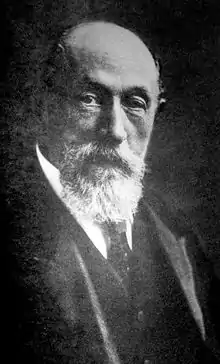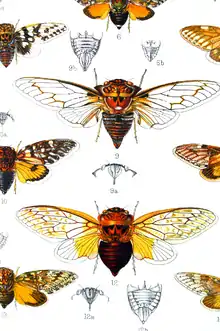William Lucas Distant
William Lucas Distant (12 November 1845 Rotherhithe – 4 February 1922 Wanstead) was an English entomologist.
William Lucas Distant | |
|---|---|
 | |
| Born | 12 November 1845 |
| Died | 4 February 1922 (aged 76) Wanstead, England |
| Nationality | English |
| Occupation | Entomologist |
| Spouse | Edith Blanche de Rubain |
Biography
Early years
Distant was born in Rotherhithe, the son of whaling captain Alexander Distant[1] and his wife, Sarah Ann Distant (née Berry).[2]
Following his father's death in 1867, a trip to the Malay Peninsula to visit his older brother, also named Alexander and a ship's captain, aroused his interest in natural history, and resulted in the publication of Rhopalocera Malayana (1882–1886), a description of the butterflies of the Malay Peninsula. (He considered 5 August 1867 as the most eventful day in his life[1]).
Career
Much of Distant's early life was spent working in a London tannery, and while employed there he made two long visits to the Transvaal. The first resulted in the publication of A Naturalist in the Transvaal (1892). The second visit, of some four years, gave him time to amass a large collection of insects, of which many were described in Insecta Transvaaliensia (1900–1911). In 1890 he married Edith Blanche de Rubain. In 1897 he succeeded James Edmund Harting as editor of The Zoologist.[1] From 1899 to 1920 he was employed by the Natural History Museum, describing many new species found in their collection, and devoting most of his time to the Rhynchota (true bugs).

His other works included Volume I of the Heteroptera and part of Volume I of the Homoptera of the Biologia Centrali-Americana (1880–1900), and the Hemiptera volumes of The Fauna of British India, Including Ceylon and Burma (1902–1918).
Later life
Distant's collection of 50,000 specimens was purchased by the Natural History Museum in 1920. He died of cancer at Wanstead.[3]
Legacy
Distant is commemorated in the scientific names of: Distantiella, a genus of mirid bugs and a species of snake, Leptotyphlops distanti.[4]
Publications
A partial list of works is as follows.[5]
- 1902-1918: The Fauna of British India, Including Ceylon and Burma. (Rhynchota volumes 1–7)
- 1900-1911: Insecta Transvaaliensia: A Contribution to the Entomology of South Africa.[6]
- A Naturalist in the Transvaal[7]
- A Monograph of Oriental Cicadidae
- Rhopalocera Malayana: A Description of the Butterflies of the Malay Peninsula
- Hemiptera
- Biologia Centrali-Americana: Insecta Rhynchota Hemiptera-Heteroptera
- Biologia Centrali-Americana
- Rhynchotal Motes: Membracidae
- "Rhynchota from New Caledonia and the Surrounding Islands" in Fritz Sarasin and Jean Roux's Nova Caledonia: Forschungen in NeuCalodonien und auf den Loyalty-Inslen – Recherches scientifiques en Nouvelle Calédonie et aux Iles Loyalty
- A Synonymic Catalogue of Homoptera
- 1912: Homoptera : fam. Cicadidae : subfam. Cicadinae.[8]
- Scientific Results of the Second Yarkand Mission: Based Upon the Collections and Notes of the Late Ferdinand Stoliczka: Rhynchota
References
- Rao, B.R. Subba (1998) History of Entomology in India. Institution of Agricultural Technologists, Bangalore.
- London Metropolitan Archives; London, England; London Church of England Parish Registers; Reference Number: P93/GEO/045.
- "Obituary – W. L. Distant". The Entomologist. London: Simpkin, Marshall & Co.: 70 1922. Retrieved 27 July 2011.
- Beolens, Bo; Watkins, Michael; Grayson, Michael (2011). The Eponym Dictionary of Reptiles. Baltimore: Johns Hopkins University Press. xiii + 296 pp. ISBN 978-1-4214-0135-5. ("Distant", p. 73).
- Dolling, W. R. (1991). Bibliographies of the works of W. L. Distant and G. W. Kirkaldy. Tymbal, suppl. no. 1: 60 pp.
- Insecta Transvaaliensia (1900–1911): OCLC 668405524; pt.4 Lepidoptera (1903) in Biodiversity Heritage Library.
- "Review of A Naturalist in the Transvaal by W. L. Distant". The Athenaeum (3386): 389–390. 17 September 1892.
- Homoptera (1912): OCLC 843365845
External links
 Media related to William Lucas Distant at Wikimedia Commons
Media related to William Lucas Distant at Wikimedia Commons Works by or about William Lucas Distant at Wikisource
Works by or about William Lucas Distant at Wikisource Data related to William Lucas Distant at Wikispecies
Data related to William Lucas Distant at Wikispecies- NDSU biographical information. Archived link. Archived 14 July 2006. Retrieved 10 December 2017.
- Works by or about William Lucas Distant at Internet Archive
- Biologia Centrali-Americana – Insecta, Hemiptera, Heteroptera-Homoptera